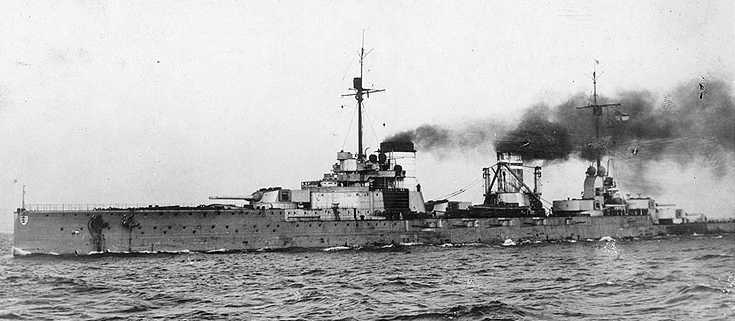A slightly more powerful gun than the previous 28 cm SK L/45. The mountings for these guns used electric pumps to drive hydraulic elevation gear while the training was all electric. The famous German/Turkish battlecruiser Goeben/Yavuz carried these guns for fifty years.
The battlecruiser Seydlitz has the unfortunate distinction of having both her after turrets burned out following damage received at Dogger Bank and then one of them burned out again at Jutland (Skagerrak). However, alterations and practices put in place following Dogger Bank are credited with saving German lives at Jutland (Skagerrak).
With the exception of Yavuz, during World War II these guns were used only as coastal artillery. They were then supplied with a lighter shell with a larger propellant charge for increased range. Four of these guns in single Drh LC/37 coastal turrets were employed as the Grosser Kurfürst battery at Pillau, latter at Framzelle, as part of the Channel defenses.
Constructed of A tube, two layers of hoops and a jacket. Used the Krupp horizontal sliding wedge breech block. A total of 36 guns were made.
All German 28 cm guns had an actual bore diameter of 28.3 cm (11.1").
| Designation | 28 cm/50 (11") SK L/50 |
|---|---|
| Ship Class Used On | Moltke and Seydlitz Classes |
| Date Of Design | 1909 |
| Date In Service | 1911 |
| Gun Weight | 91,491 lbs. (41,500 kg) 1 |
| Gun Length | 557.1 in (14.150 m) |
| Bore Length | 528.4 in (13.421 m) |
| Rifling Length | 445.4 in (11.114 m) |
| Grooves | (80) (2.8 mm D x 6.92 mm W) |
| Lands | (4.2 mm) |
| Twist | Increasing RH 1 in 45 to 1 in 30 at the muzzle |
| Chamber Volume | 9,154 in3 (150 dm3) |
| Rate Of Fire | 3 rounds per minute 2 3 |
- ^The often-seen figure of 149,914 lbs. (68,000 kg) for this weapon actually includes the weight of the Weige (gun cradle).
- ^The hoists could supply three rounds per gun in 51 seconds, including loading and unloading the hoists, and the firing cycle with a strong and well trained crew was about 20 seconds. However, this rate was rarely achieved in battle.
- ^During the Dogger Bank battle in 1915 Seydlitz was in continuous action for two hours. During that time, she averaged a firing rate of one salvo every 42.3 seconds, an impressive performance considering that the guns were hand worked.
| Type | Cartridge - Bag |
|---|---|
| Projectile Types and Weights 1a 2a | World War I - Ship and Coastal Artillery Projectiles
APC L/3,2: 665.8 lbs. (302.0 kg) 3a 4a HE L/3,6 base fuze: 665.8 lbs. (302.0 kg) World War I - Coastal Artillery Projectiles
World War II - Coastal Artillery Projectiles
|
| Bursting Charge | World War I 9a APC L/3,2: 19.74 lbs. (8.95 kg) TNT 10a HE L/3,6 base fuze: 40.53 lbs. (18.385 kg) TNT 11a HE L/4,6 base fuze: 40.53 lbs. (18.385 kg) TNT 11a HE L/4,4 base and nose fuze: 51.13 lbs. (25.19 kg) TNT 12a Shrapnel L/3,5: 2,809 spherical balls and pitch filler weighing 163.0 lbs. (73.9 kg) World War II 13a |
| Projectile Length | APC L/3,2: 35.6 in (90.4 cm)
HE L/3,6 base fuze: 39.6 in (100.6 cm) HE L/4,6 base fuze: 51.5 in (130.8) cm HE L/4,4 base and nose fuze: 50.0 in (127.0 cm) Shrapnel L/3,5: 38.7 in (98.3 cm) |
| Propellant Charge 17a 18a 19a | Before World War I 20a Full Charge: 211.2 lbs. (95.8 kg) RP C/06 Reduced Charge: 165.5 lbs. (75.0 kg) RP C/06 World War I
World War II 21a - or - Fore Charge: 95.7 lbs. (43.4 kg) RP C/38 (1240/1230 x 18/8)
World War II - For HE L/4,4 base and nose fuze
|
| Cartridge Case Type, Size and Empty Weight 23a | Brass, 283 x 1271 mm, about 99.2 lbs. (45.0 kg) 24a |
| Muzzle Velocity | World War I & World War II: 2,890 fps (880 mps)
World War II - HE L/4,4 nose and base fuze: 2,940 fps (895 mps) |
| Working Pressure | 20.2 tons/in2 (3,180 kg/cm2) |
| Approximate Barrel Life | N/A |
| Ammunition stowage per gun | Moltke: 81 rounds
Seydlitz: 96 rounds for centerline guns and 81 rounds for wing guns |
- ^
Actual designations for Projectiles APC L/3,2 28 cm Psgr. L/3,2 HE L/3,6 base fuze 28 cm Spgr. L/3,6 Bdz HE L/4,6 base fuze 28 cm Spgr. L/4,6 Bdz (m.Hb) HE L/4,4 base and nose fuze 28 cm Spgr. L/4,4 Bdz u. Kz (m.Hb) Shrapnel L/3,5 28 cm Stahlschrapnel L/3,5 - ^Most if not all of these projectiles were also issued for the 28 cm/45 (11") SK L/45 guns.
- ^3.13.2The weight of the APC L/3,2 appears in most references as 665.8 lbs. (302.0 kg). However, M.Dv. Nr. 190,1A2 lists the schußfertig (ready for shooting) weight as 665.8 lbs. (302.0 kg), but a sketch in this document shows the weight as 662.9 lbs. (300.7 kg), which may be the World War II weight. A post-war British sketch shown in "Diagrams of Great War" shows the weight as 700 lbs. (317 kg). The weight given in M.DV. Nr. 190,1A2 is used here.
- ^The HE L/4,6 base fuze was the HE L/3,6 base fuze with a ballistic cap added.
- ^The HE L/4,4 base and nose fuze was a modified HE L/3,6 with a ballistic cap and the projectile nose modified to allow a nose fuze and fuze actuator rod (Stößel) to be used. See sketch below.
- ^There were at least three different models of the HE L/4,4 base and nose fuze projectile. The one listed here was the heaviest with the others being a few kilograms lighter. See sketches below.
- ^German HE Base and Nose Fuzed projectiles with ballistic caps had a rod between the nose of the shell and the fuze to improve performance when striking obliquely. See details on the 12.7 cm SK C/34 datapage.
- ^Burster weights (reiner Sprengstoff) for World War I projectiles from "Diagrams of Great War" and from from M.Dv. Nr. 198.
- ^The World War I APC burster consisted of two parts, both made from Fp 2. There was a wooden block in the nose of the burster cavity which acted as a shock absorber.
- ^The burster for the World War I HE L/4,4 base and nose fuze projectile consisted of two parts. There was a wooden block in the nose of the burster cavity which acted as a shock absorber.
- ^Burster weights (reiner Sprengstoff) for World War II projectiles from M.Dv. Nr. 198 which gives two weights for The HE L/3,6 and HE L/4,4 shell types. This is related to the way that the bursters were packaged in the cavity. Both weights are included here for reference.
- ^The burster for the APC L/3,2 projectile of World War II was made from Fp 15 and Fp 1.
- ^The burster for the HE L/3,6 base fuze projectile of World War II was made from Fp 15, Fp 10, Fp 5 and Fp 1.
- ^The burster for the HE L/4,4 base and nose fuze projectile of World War II was made entirely with Fp 1.
- ^These guns, like most large caliber German guns of this era, used a "fore charge" which was propellant in a double bag silk case and a "rear charge" which was propellant in a brass case. The brass case helped to seal the breech of the gun.
- ^Propellant weights differ in many references and even in official documents such as the M.Dv. Nr. 170 and M.Dv. Nr. 190 series. This seems to be the result of most charges being listed as "zu etwa" which means "to about." This was probably because the different propellant formulations used - such as C/32 or C/38 - varied in weight. In addition, different loading weights were used depending upon the powder grain size utilized to make up the charge. The weights in the table above are for the powder grain specified.
- ^Except as noted, most of these propellant charges were also issued for the 28 cm/45 (11") SK L/45 guns.
- ^I lack the individual weights of the pre-World War I rear and fore charges.
- ^The RP C/32 charge was only used for the 28 cm SK L/50 guns.
- ^Silk bag for the fore charge weighed 3.3 lbs. (1.5 kg).
- ^During World War I the same cartridge case was used for the 28 cm SK L/40, 28 cm SK L/45 and 28 cm SK L/50 guns. During World War II it appears that the same cartridge case was still used for these three guns and for the newer 28 cm SKC/28 and 28 cm SKC/34 guns.
- ^The cartridge rim diameter was 320 mm.
| Elevation | Distance |
|---|---|
| 13.5 degrees
(maximum elevation as built) |
19,790 yards (18,100 m) |
| 16.0 degrees
(maximum elevation after 1915) |
Moltke, Seydlitz: 20,890 yards (19,100 m) |
| 22.5 degrees
(Goeben elevation 1918) |
23,730 yards (21,700 m) |
The World War I projectiles are described as "having a rather blunt head," resulting in only a slight increase in range for the higher elevations.
| Projectile | Distance |
|---|---|
| APC L/3,2 | N/A |
| HE L/3,6 base fuze | 31,036 yards (28,380 m) |
| HE L/4,6 base fuze | 35,870 yards (32,800 m) |
| HE L/4,4 base and nose fuze | 42,400 yards (38,600 m) |
| Shrapnel L/3,6 | 25,043 yards (22,900 m) 1b |
- ^Shrapnel was fired only with reduced charges.
| Range | Penetration |
|---|---|
| At the Dogger Bank battle in 1915, these guns are credited with penetrating the 5" and 6" (12.7 and 15.2 cm) side armor belts of the British Battle Cruisers. | |
| Designation | Two-gun Turrets
Moltke class (5): Drh LC/1908 Seydlitz class (5): Drh LC/1910 Single Coastal Artillery Turrets
|
|---|---|
| Weight | Drh LC/1908: 437.5 tons (444.5 mt)
Drh LC/1910: (443.5 to 456.7 mt) |
| Elevation 1c | All as built: -8 / +13.5
All after 1915: -5.5 to +16.0 degrees Goeben: First increased to +16.0, then to +22.5 degrees Coastal artillery: -5 / +50 degrees |
| Elevation Rate | Drh LC/1908: 4 degrees per second
Drh LC/1910: N/A Coastal Artillery: 10 degrees per second with shell loaded |
| Train | End Turrets: About +150 / -150 degrees
Beam Turrets: About +80 / -80 degrees Coastal Artillery: -220 / +220 degrees |
| Train Rate | Drh LC/1908: 3.3 degrees per second
Drh LC/1910: 3.0 degrees per second Coastal Artillery: 4 degrees per second |
| Gun recoil | 33.1 in (84 cm) 2c |
| Loading Angle | Drh LC/1908: 2 degrees
Drh LC/1910: 2 degrees Coastal Artillery: 0 degrees |
- ^Mountings were modified after Jutland (Skagerrak) to increase the maximum elevation from +13.5 to +16 degrees. The mountings on Goeben were modified in 1918 to +22.5 degrees in an effort to help her fight the Russian battleships armed with 12" (30.5 cm) guns.
- ^The recoil distance given above is the nominal figure. The absolute, metal-to-metal recoil distance was 35.4 inches (90.0 cm).
- The guns were individually sleeved but could be coupled together by the elevation gear. Guns were hydraulically elevated. Loading, ramming and the breech mechanism were all hand operated. Shell rooms were below the magazines. A post-war British inspection team was impressed by the spacious magazines in Goeben and 'the arrangement transporting the heavy rear charge from the bays to the handling room door being particularly ingenious and easy to manipulate.' The lower shell and charge hoists ran up to a handling room below the gunhouse. The upper shell hoists came up between and behind the guns and the shells were rolled into the shell tray. When the charges came into the gunhouse, the fore charge was removed by hand and placed into the propellant loading tray while the rear charge was tilted onto the other part of the tray. Both shell and charge trays were out of the path of the recoiling gun which meant that they could be loaded while the guns were firing, increasing the rate of fire. Trays were then moved to the loading position where they were rammed by hand. See photographs below for details.
- Seydlitz had 62 complete charges ignited during the Dogger Bank battle and both 'C' and 'D' mountings burned out but there was no explosion. Following the Dogger Bank action, German mountings were modified to improve flash protection but this process was not complete at the time of Jutland (Skagerrak). Modifications included double flap doors installed at the beginning and end of the cartridge hoists and new bayonet clasps were added to the cartridge tins used to store the fore charges. In addition, ammunition handling was changed such that the fore charges were kept in the tins until they reached the gun breeches; rear charges were kept protected until they were ready to load. Charges were not allowed to pile up in the gunhouse. Finally, all ready ammunition was removed from the gun houses. When Seydlitz was struck and again penetrated at Jutland (Skagerrak) the resulting fire in "C" mounting was much smaller, involving only two rear and two fore charges.
- Each turret required 70 men to operate including twelve men for each gun in the gunhouse.
- Magazines were located above the shell rooms.
Armor thickness given in "Naval Weapons of World War One" by Norman Friedman and in "German Battlecruisers of World War One" by Gary Staff Drh LC/1908 Drh LC/1910 Face 9.0 in (23 cm) 9.8 in (25 cm) Sides 7.1 in (18 cm) 7.9 in (20 cm) Rear 9.0 in (23 cm) 8.3 in (21 cm) Roof 2.4 to 3.5 in (6 to 9 cm) 2.8 to 3.9 in (7 to 10 cm)
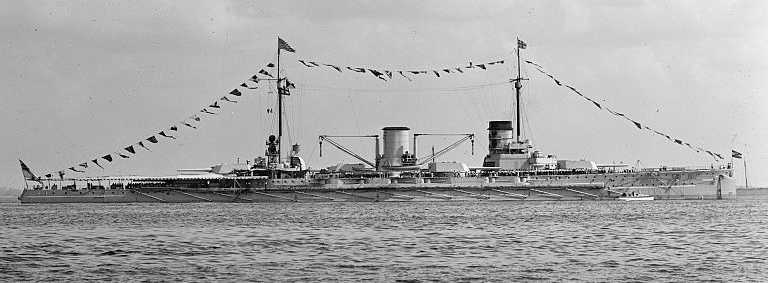

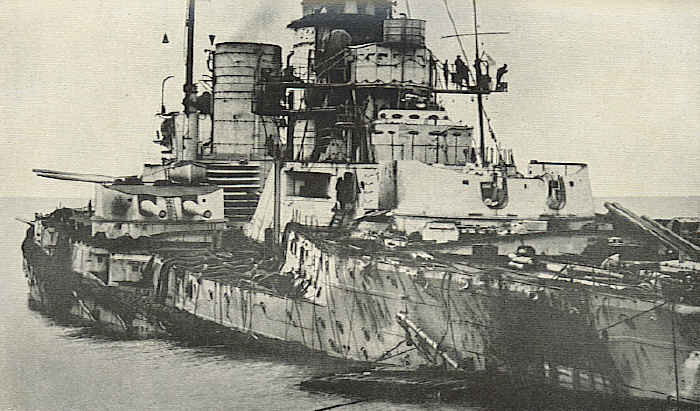
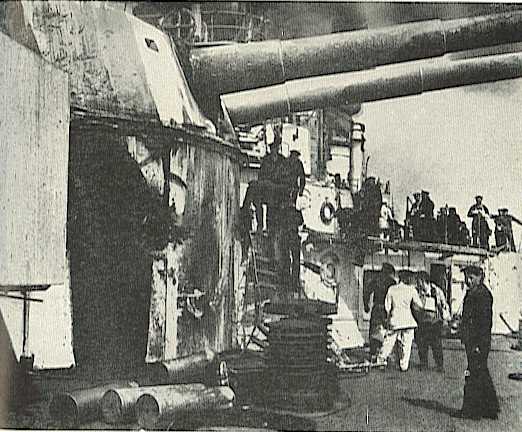

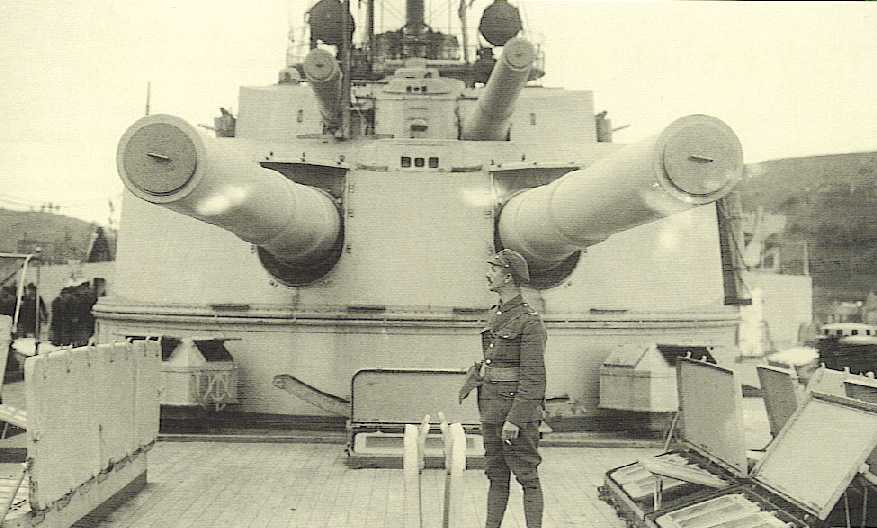
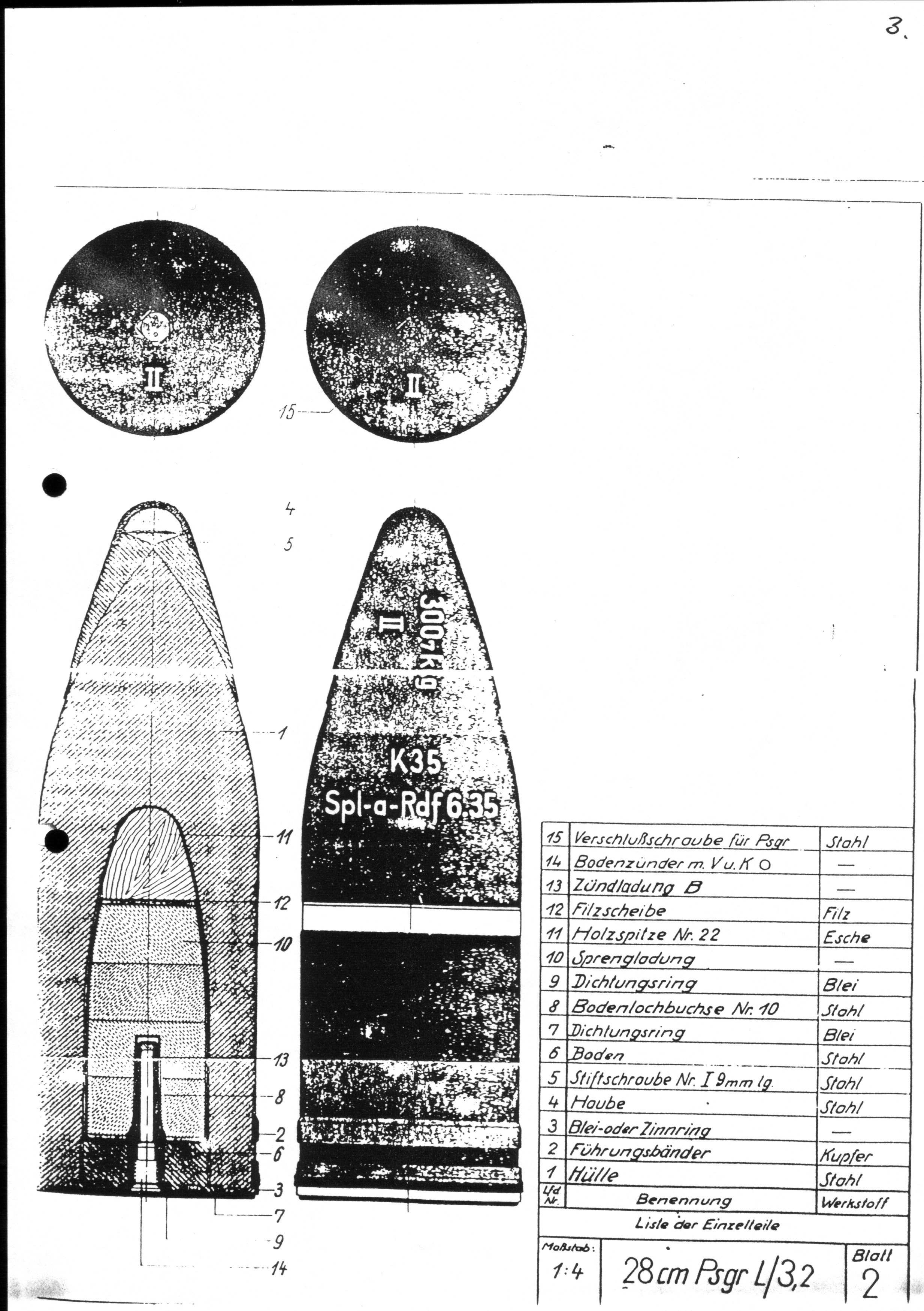
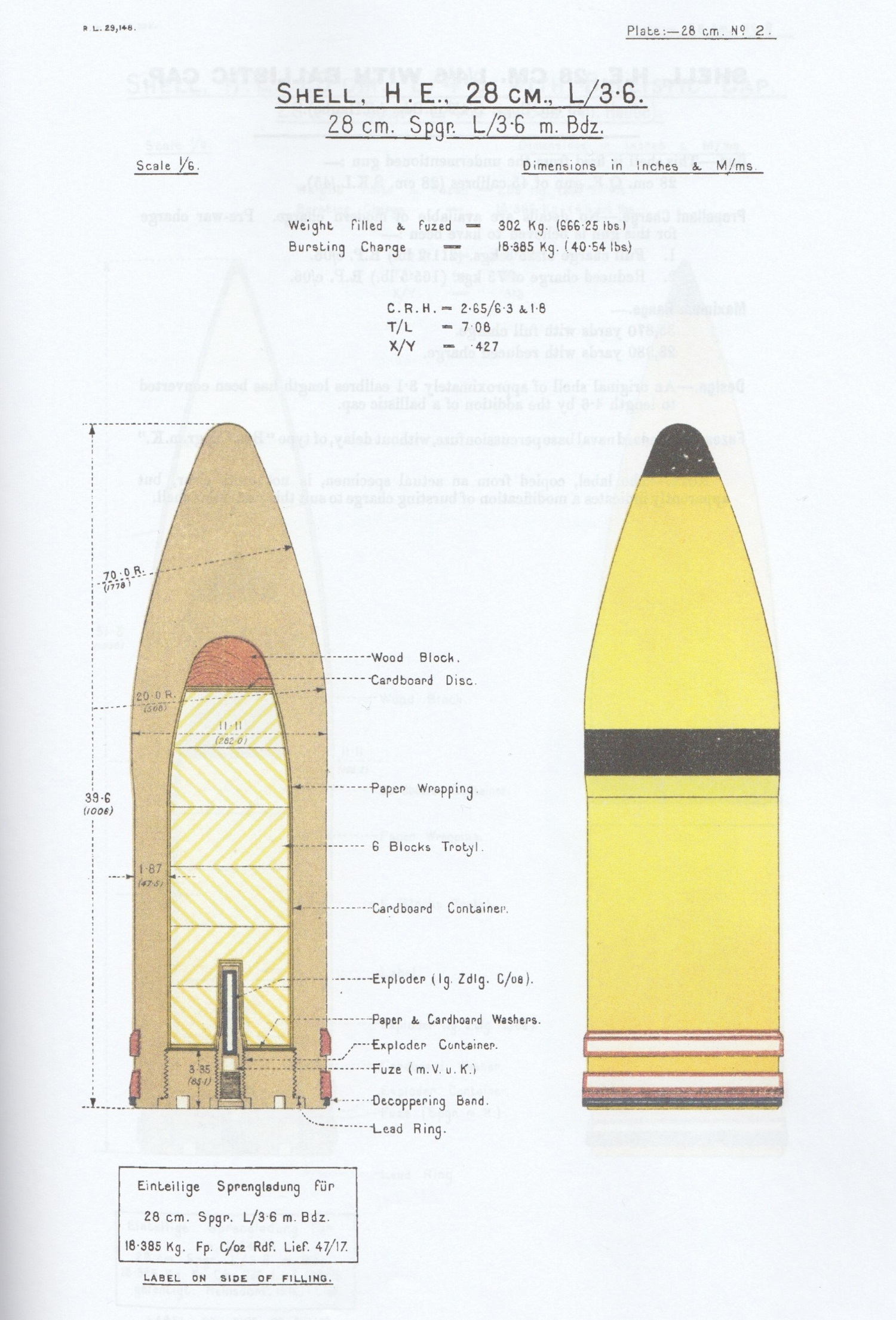
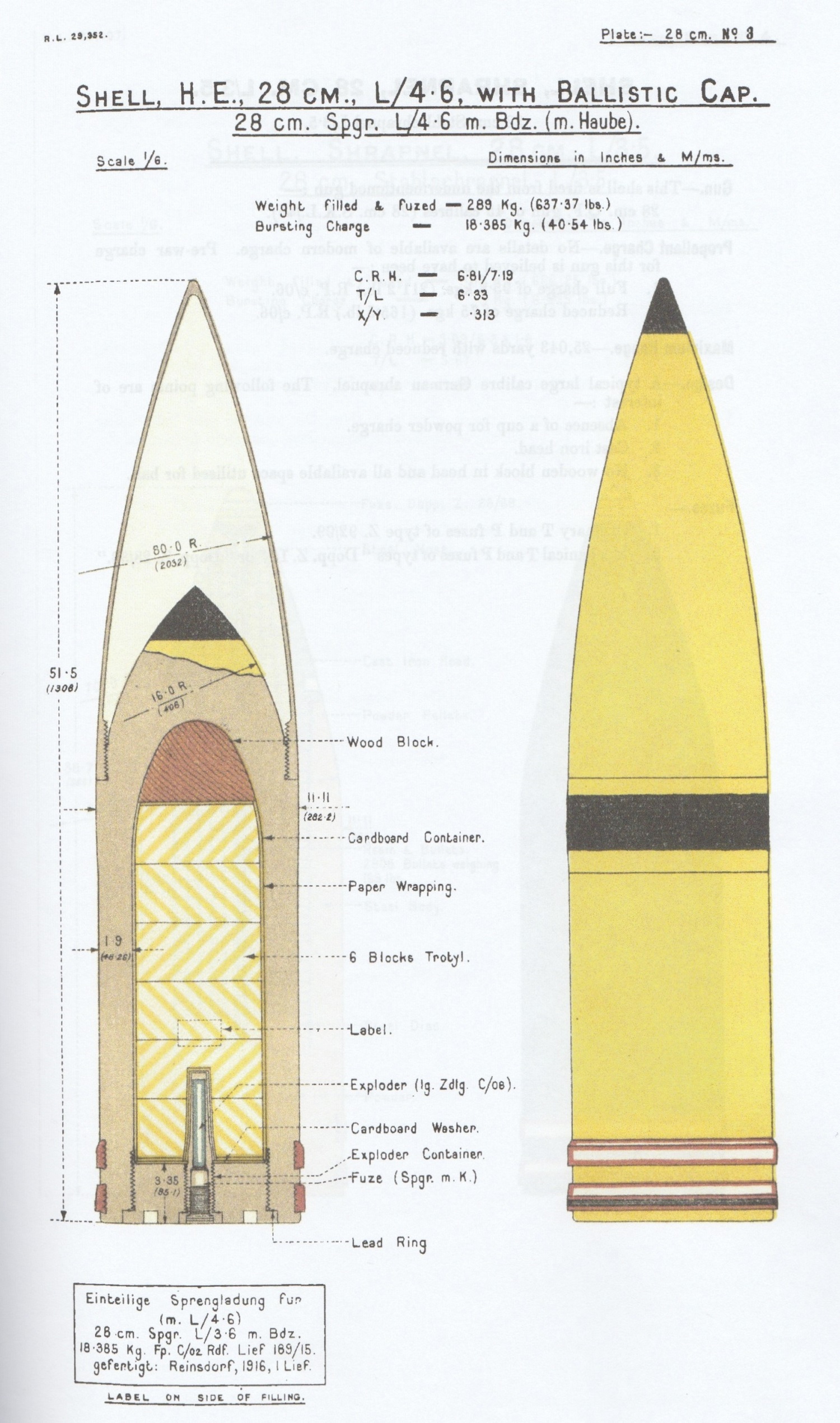
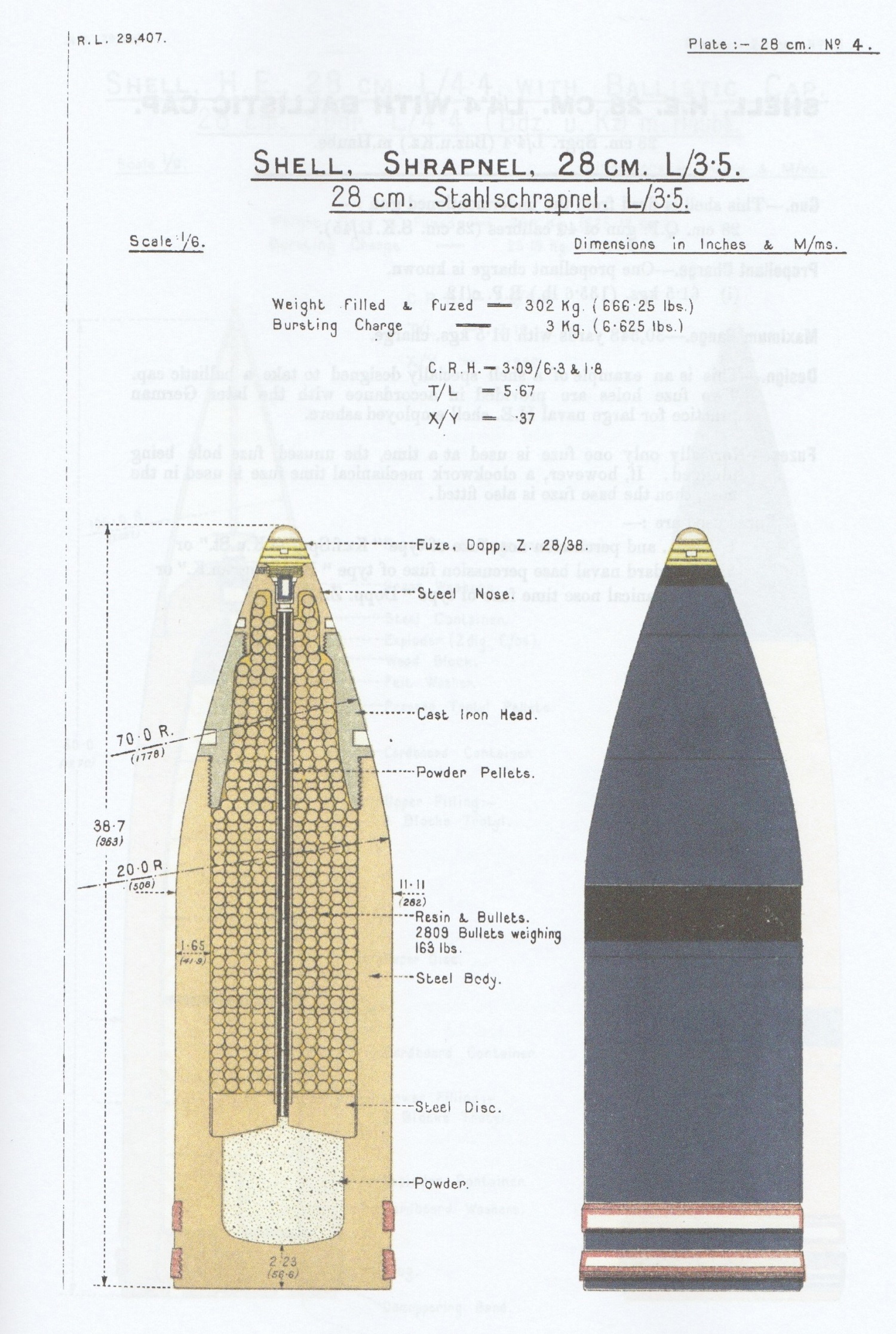

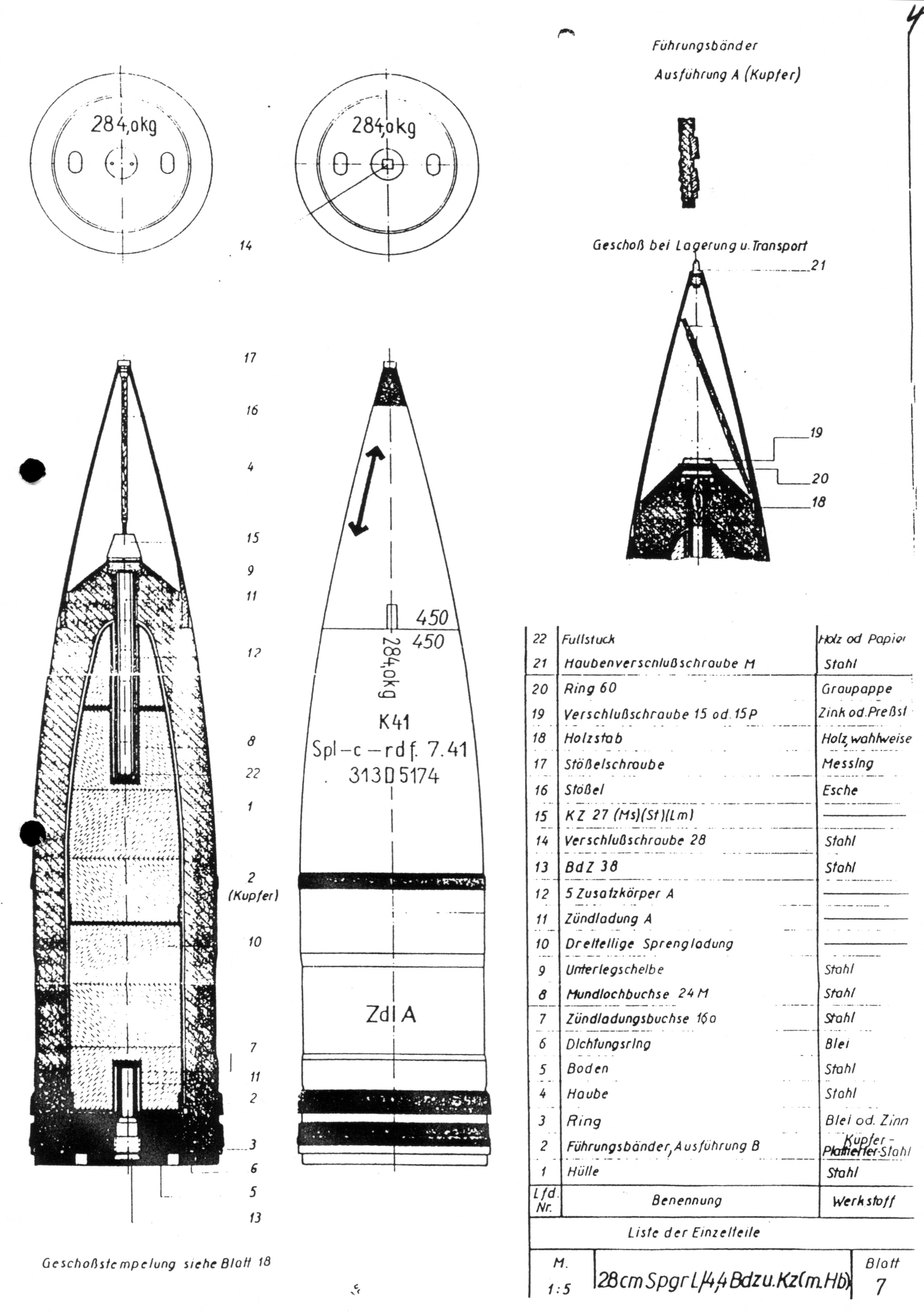
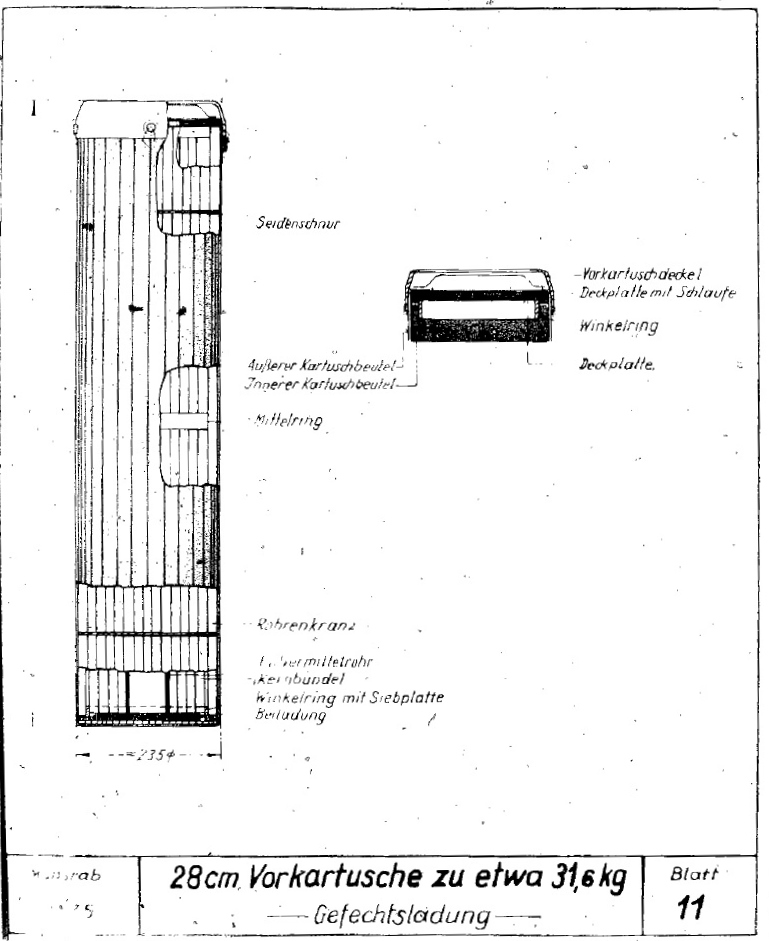
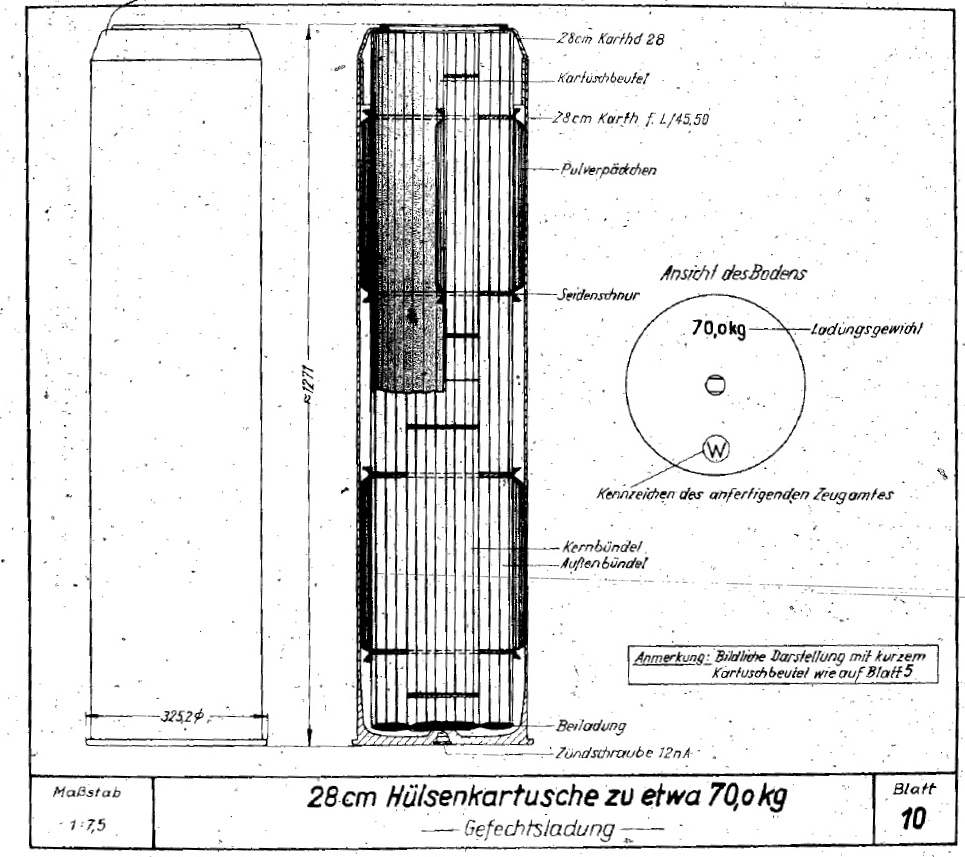
Historical Note: Mr. Bowden was one of the leaders of the effort to preserve Yavuz as a War Memorial and traveled to Turkey in 1966 to document the state of Yavuz as a part of that project.
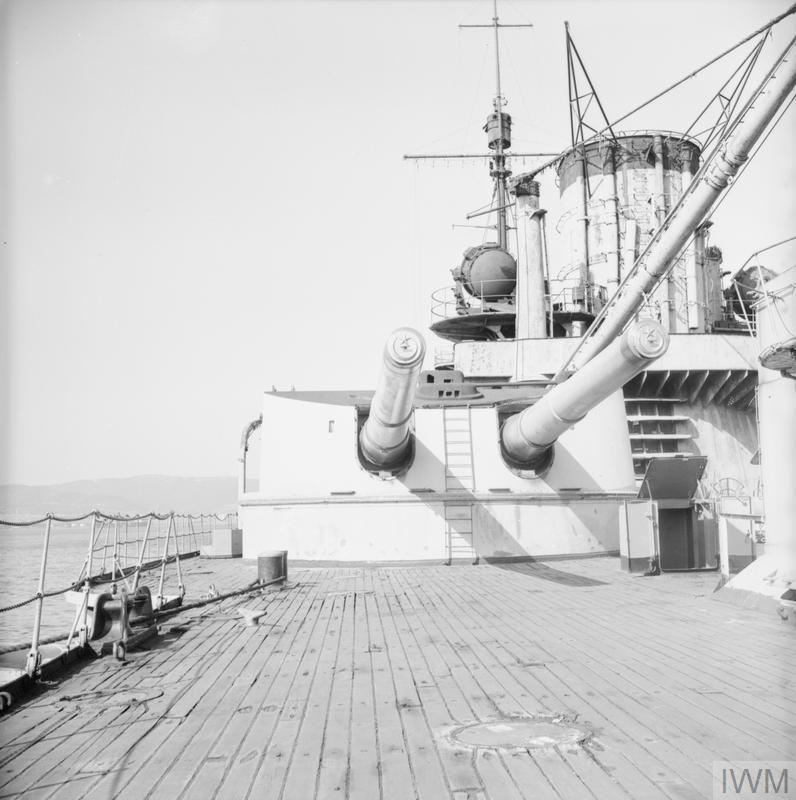
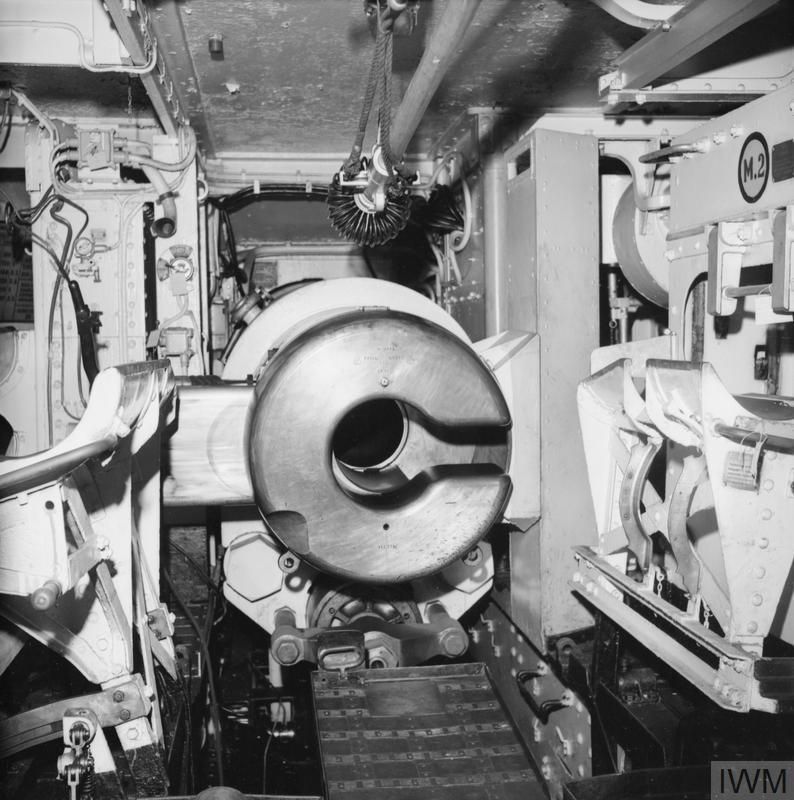
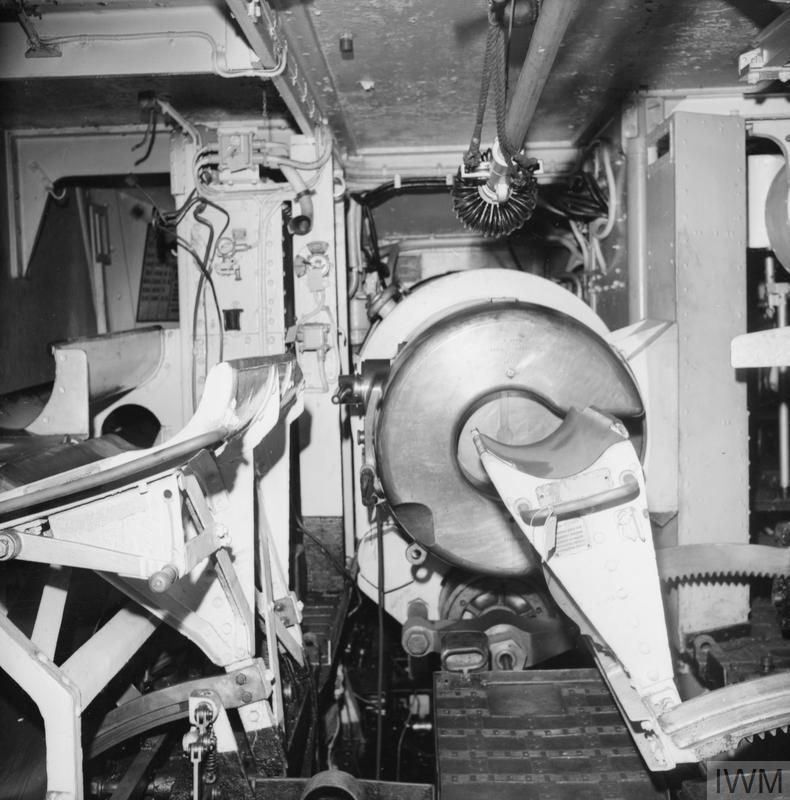
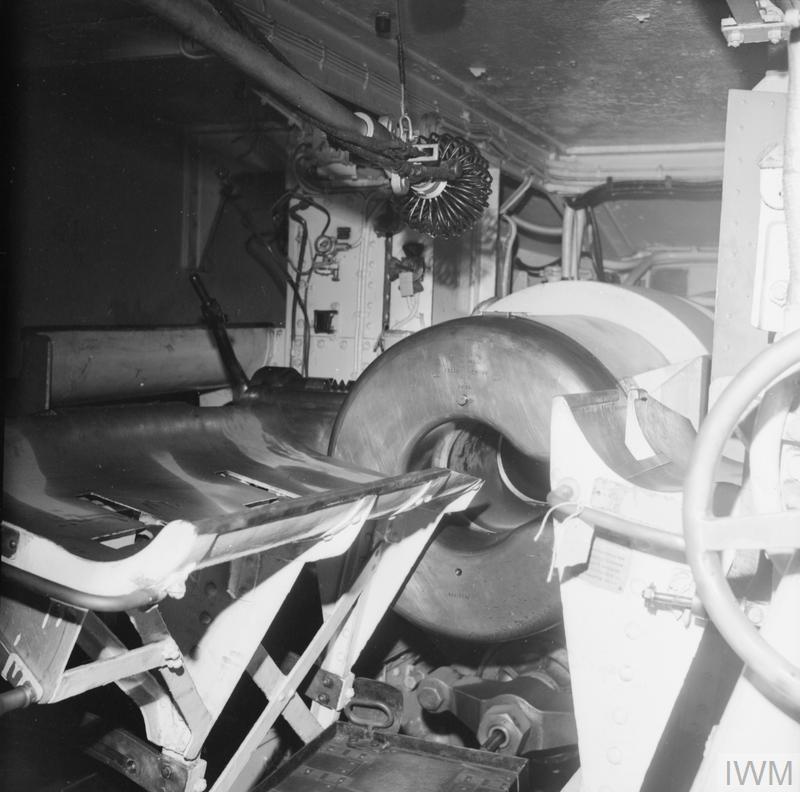
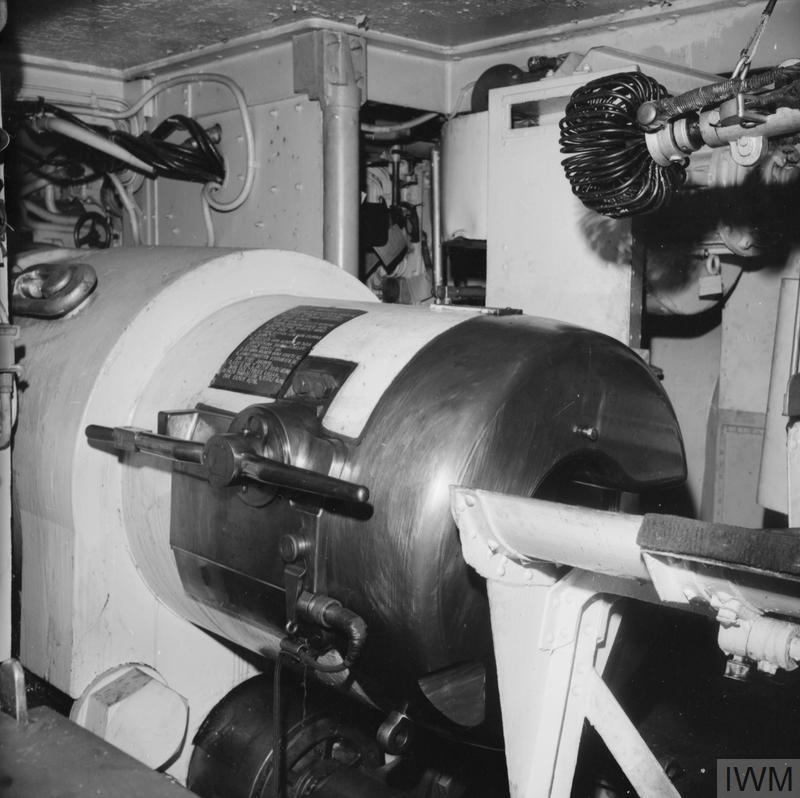
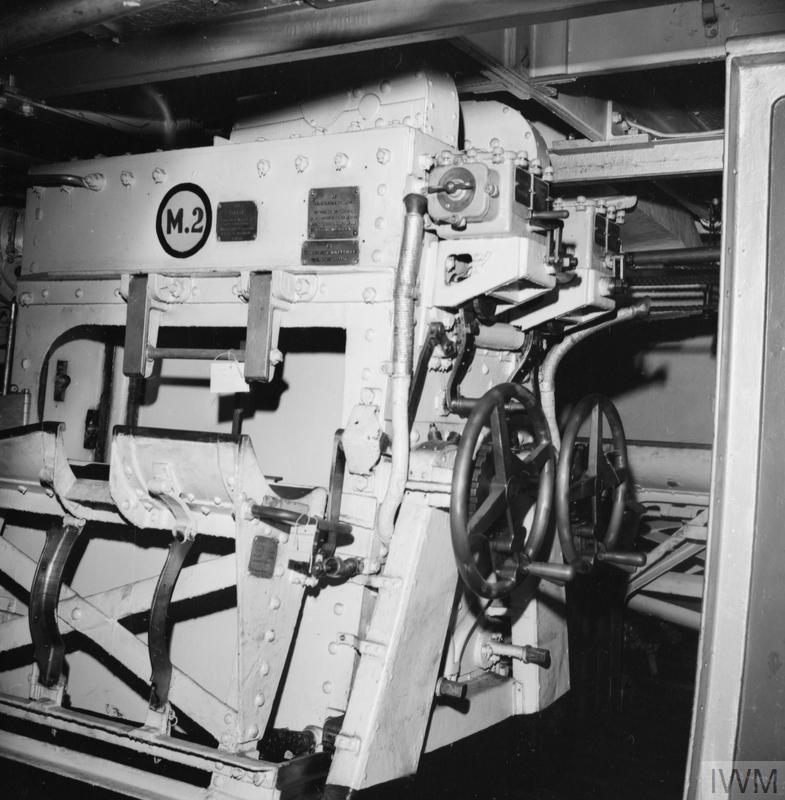
A Note on Sources: "Naval Weapons of World War One" states that a foot pedal operated the shell loading tray, but based upon the photographs in this series, it appears that a hand lever was used to operate the shell tray while a foot pedal was used to unlock the propellant tray. Photograph from the Aubrey Houston Bowden collection, IWM photograph Q 71797.
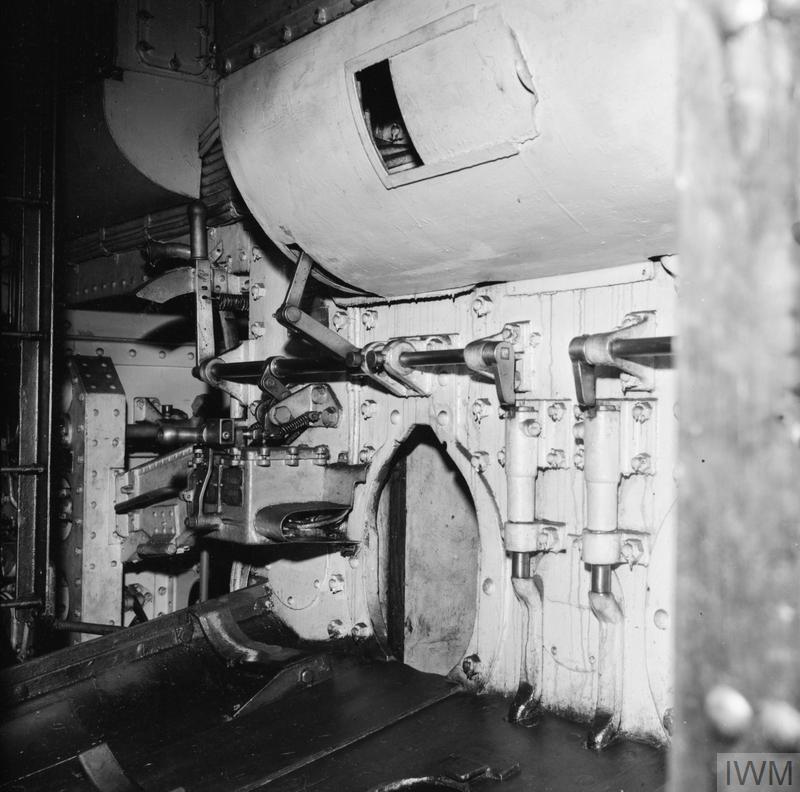
"Jutland: An Analysis of the Fighting" and "Naval Weapons of World War Two" both by John Campbell
"Skagerrak" by Arno Dohm
"Naval Weapons of World War One" by Norman Friedman
"The King's Ships Were at Sea: The War in the North Sea August 1914 - February 1915" by James Goldrick
"German Warships 1815-1945" by Erich Gröner
"The Big Gun: Battleship Main Armament 1860-1945" by Peter Hodges
"Battleships of World War I" by Peter Hore
"Die Geschichte der deutschen Schiffsartillerie" by Paul Schmalenbach
"German Battlecruisers 1914-18," "German Battlecruisers of World War One: Their Design, Construction and Operations" and "Battle on the Seven Seas: German Cruiser Battles 1914 - 1918" all by Gary Staff
"The Ship that Changed the World: The Escape of the Goeben to the Dardanelles in 1914" by Dan van der Vat
"Admiral von Hipper" by Capt. Hugo von Waldeyer-Hartz
"German Capital Ships of World War Two" by M.J. Whitley
---
"Diagrams of Great War - German Naval Guns; Shells & Explosives; Fuses & Exploders" by The Royal Laboratory Woolwich 1921-22
"Vorläufige Beschreibung der 28 cm S.K.L/45, 28 cm S.K.L/50 und 30,5 cm S.K.L/50 in Kst.Drh.L.C.37" M.Dv.Nr. 234.6 Berlin 1941, Oberkommando der Kriegsmarine
"Munitionsvorschriften für die Kriegsmarine - Panzersprenggranaten (Psgr)" M.Dv. Nr. 190,1A2 by Oberkommando der Kriegsmarine
"Munitionsvorschriften für die Kriegsmarine - Sprenggranaten (Spgr)" M.Dv. Nr. 190,1A3 by Oberkommando der Kriegsmarine
"Munitionsvorschriften für die Kriegsmarine - Hülsenkartusche" M.Dv. Nr. 190,4A1 by Oberkommando der Kriegsmarine
"Munitionsvorschriften für die Kriegsmarine - Vorkartusche" M.Dv. Nr. 190,4A6 by Oberkommando der Kriegsmarine
"Übersicht über die für die Marinegeschütze und deren Abk K zu verwendende Munition und ihre Einzelteile einschließlich Salut-
und Manöverladungen" M.Dv. Nr. 198 by Oberkommando der Kriegsmarine
---
U.S. Naval Technical Mission in Europe - Technical Report No. 393-45, September 1945, "Service Major Caliber Projectiles of the German Navy"
---
Special help from Peter Lienau and Thorsten Wahl
24 April 2008 - Benchmark
11 January 2009 - Added picture of Moltke
26 August 2011 - Added comment about Seydlitz turret burn-outs and additional projectile information
19 May 2012 - Updated to latest template
24 November 2012 - Added details about guns, ammunition and mountings
05 December 2012 - Added amidships picture of Seydlitz
05 March 2019 - Converted to HTML 5 format, reorganized notes and added data and sketches from M.Dv. Nr. 190,1A3,
M.Dv. Nr. 190,4A1 and M.Dv. Nr. 190,4A6
20 December 2019 - Additional detail added regarding the changes made to the mounting and ammunition handling
procedures following the Dogger Bank battle.
07 March 2020 - Added ammunition information
05 June 2020 - Added Aubrey Houston Bowden collection photographs of Goeben / Yavuz
14 January 2022 - Added details to "zu etwa" note
16 November 2022 - Added information and sketches on World War I coastal artillery projectiles
31 December 2022 - Corrected typographical error and added Note on Sources for the (m.Hb) designation
28 August 2024 - Added burster notes, propellant information and muzzle velocity

